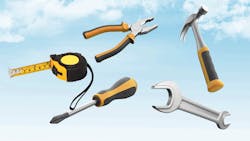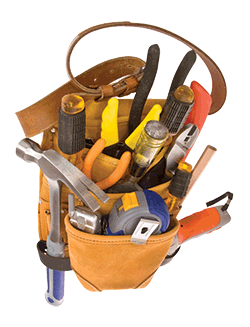The Sky Isn't Falling (And Your Tools Shouldn't Either)
For all objects at height – including humans – the focus always should be on preventing things from falling rather than on catching objects, or on limiting the damage after they fall.
Dropped objects have been a problem for as long as the force of gravity has existed, and have been written about for at least a century. In fact, the New York Times published an article in 1903 about dropped objects in which it said: "Dozens of placards posted at various places on the bridge caution the iron workers to use great care in the handling of tools, to avoid dropping them into the river."
Yet here we are today, having the exact same conversation. And, with the number of things we're dropping, it's amazing more people are not getting hurt. There are more than 50,000 "struck by falling object" OSHA recordables every year in the United States, according to the Bureau of Labor Statistics. That's one injury caused by a dropped object every 10 minutes.
Despite OSHA statistics – and the fact that many of these violations could have been prevented with the proper safety equipment – many contractors do not take the necessary precautions to prevent fall-related injuries by providing workers with personal fall protection systems for both the workers and their tools.
The Dangers of Dropped Objects
Are all accidents preventable? Fewer than 25 percent of construction workers think they are.
While that's debatable, what's clear is that workers often see themselves as the victims of accidents, not as the cause of them.
To determine what kind of force an object falling from a certain height generates, calculations can be done around the physics of gravity. For example, an eight-pound wrench dropped 200 feet would hit with a force of 2,833 pounds per square inch – the equivalent of a small car hitting a one-square-inch area.
Needless to say, if that worker on the statue in Rio de Janeiro had dropped his hammer and it had hit a visitor below, it likely would have caused a fatality.
In another example, a man delivering sheet rock to a construction site in Jersey City was killed by a tape measure. The independent contractor for a trucking company was leaning into a car window to speak with someone and when he pulled his head out, he was struck by a one-pound tape measure that had slipped out of a worker's hands 50 stories above.
Changing Our Perspective about Dropped Objects
In the United States, we expect workers at height to wear a fall protection harness and be tied off. Why? Because we're trying to prevent people from falling. But we've done nothing to prevent tools from falling because there is an expectation that objects will fall.
Too frequently, we rely on debris nets, toe boards and personal protective equipment (PPE) to catch the falling objects or limit the damage they do. But what we really need to do is stop things from falling in the same way we have worked diligently towards preventing people from falling.
There are more than 52,260 recorded incidents of people being struck by falling objects in the last recording period, according to OSHA. This number likely is much lower than the actual number, of course, but this would mean that, on average, nearly 143 objects strike people every day – including Saturdays and Sundays – in the United States alone.
As we know, people are not designed to work at height. They don't have a natural "connection point" to tie off to. That's why they wear a fall protection harness: to provide that connection point. Tools are not designed for use at height either. That's why we also need to provide a fall protection harness and connection point for tools – so they easily can be tied off.
A harness for a person acts as the primary component of a personal fall protection system. However, for tools, we typically rely on secondary, passive systems, such as debris nets. We rarely deploy a primary system for tools and equipment.
Most organizations have deployed a fall protection program for workers but have not deployed a drop prevention program for tools and equipment. Expanding a fall protection program to include tools and equipment is far easier for companies and employees than creating a new program for drop prevention.
The difference between a fall protection program for humans and fall protection program for tools is only a matter of perspective: The first saves you; the second saves others.
No worker wants to fall to his death. But no one wants to be the worker in Jersey City who dropped the tape measure and killed a man either. And no crew or company wants to be associated with an incident like that, which was all over the news.
While the most obvious person at risk when objects are dropped is the one underneath, the worker using the tool also can be at risk, as his knee-jerk reaction may be to catch or go after the falling object, which could cause him to lose his balance and fall.
How to Use Fall Protection Gear for Tools
When using fall protection equipment for tools, there are five simple rules to follow:
- Make sure the lanyards, attachment points and wristbands allow you to use the tool with little to no interference.
- To help maintain your tool's functionality, you should not need to modify the tool to effectively attach them. Products like D-rings, self-vulcanizing tape, tool cinch attachments and quick spins and rings can complement the design and functionality of the tool without altering them.
- Tools over five pounds should be secured to a fixed structure or anchor point approved by the site and that is safe to use as a tether.
- Pay attention to the load rating. For example, if a tether that is load rated for five pounds is connected to an attachment point rated for two pounds, the load rating or the lesser of the two components should be followed.
- Be brand loyal because systems often are built and designed to work together for maximum effectiveness.
The fourth leading cause of death in the workplace is falls. Falls were the third largest cause of death, but the increased use of fall protection equipment by workers has lowered the death rate from falls.
OSHA requires that if you work in an environment in which you're at risk of being hit by something that falls, you must:
- Secure tools and materials to prevent them from falling on people below.
- Barricade hazard areas and post warning signs.
- Use toe boards, screens on guardrails or scaffolds to prevent falling objects.
- Use debris nets, catch platforms or canopies to catch or deflect falling objects.
OSHA can use the General Duty clause to cite companies when dropped objects have caused injuries or are a hazard, but OSHA rarely cites a company for dropped objects under the General Duty clause. The clause says there must be a hazard; the hazard must be recognized; the hazard causes or is likely to cause injury or death; and the hazard must be correctable.
However, if no one is cited for it, then there is no incentive for companies to follow it.
Here is an incentive: Within the next five to 10 years, OSHA likely will mandate that all tools must be tied off. In the meantime, it's up to companies and workers to do the right thing.
One company recently called me in to help with dropped objects because workers had dropped a pair of pliers and a spud wrench. When I arrived and explained the reason for my visit, one executive commented, "Just those two? We've had over 90 drops in the last 90 days."
With those kinds of numbers, it really is incredible that falling objects aren't causing more injuries than they already are.
Too often, companies only invest in safety after a tragic event occurs. Although most companies now recognize the hazards of working at height, the next step is for them to realize that fall protection – for people and tools and equipment – must be addressed before an incident, not after, to help improve the personal safety of workers while working at height.
Sidebar: Dropped Objects Best Practices and Solutions
Below is a look at the Top 15 best practices and solutions for organizations when it comes to dropped object prevention:
Mark Caldwell is director of fall protection for tools at Capital Safety. As the former CEO of Python Safety, Caldwell drives the strategic vision and direction of 3M's Python Safety business unit. Python Safety was acquired by Capital Safety in early 2015.



